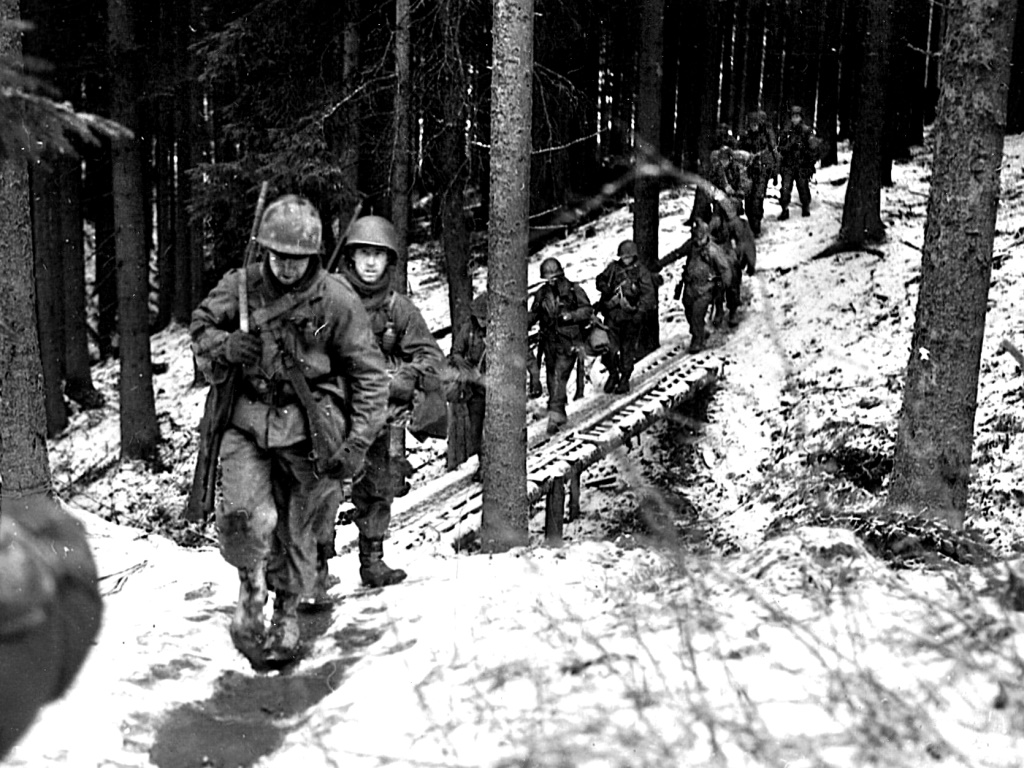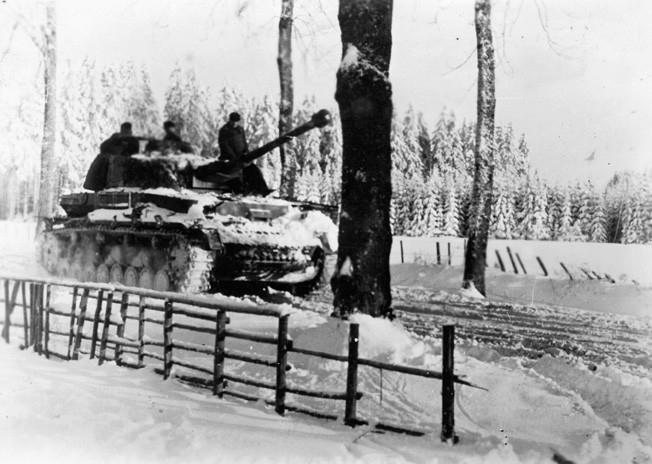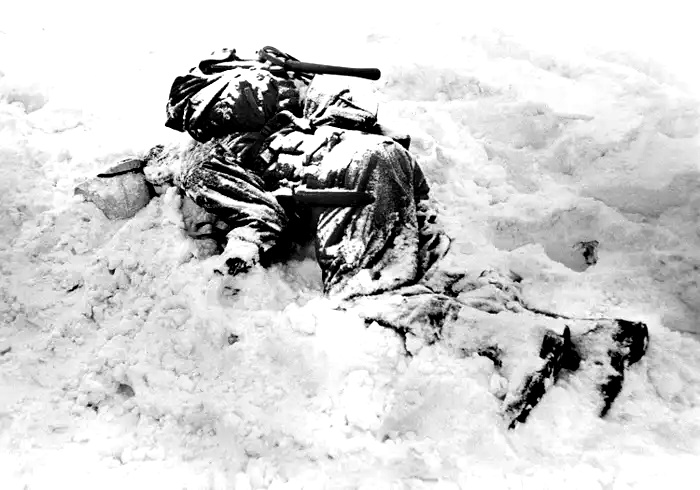The 423-IR was to attack the left of the 422-IR from the south. Their location at this time was not known since contact had been lost earlier in the day. The mission was to capture Schoenberg and continue the withdrawal to the west in an effort to break through the German encirclement. The regiment was to attack three battalions abreast. The 3/422 was to try and gain contact with the 423-IR on its left. The direction of attack was to be generally northwest until within approximately 1000 yards of Schoenberg, then it was to change direction and attack to the west. The 1/422 was to cross the Schoenberg – Andler road and attack to the southwest. Its zone of attack was bounded on the left by the Schoenberg – Andler road and on the right by the Auw River.
In the event, the 3/422 was pinched off by the 423-IR, which was attacking from the south, it would follow the 2/422 and be prepared to attack in either the first or second Battalions zone. The battalions were to move individually cross-country by compass direction to their final assemble areas which had been designated by the regimental S-3: 1/422 – Woods B, 2/422 – Woods E, 3/422 – Woods D, and be prepared to launch the attack at 0700 on December 18. At approximately 1830, the 1/422 started its move by compass direction only to its final assembly area in Woods B, a distance of approximately 1800 yards. It was rough going cross country with the ground covered with ice and snow. Like the regimental march, there had been no recon and the direction was by compass only. There were frequent stops to allow patrols to search the area to the front for any enemy before it moved. This gave the men a little time for a much-needed rest. They had been hand-carrying their heavy weapons and all the ammunition they could since the march started. Even though they were tired, cold, and hungry, their morale was excellent and their spirits were high.
It was approximately 2400 when the battalion finally closed in the little patch of woods that was its final assembly area. The companies were assigned sectors and each was responsible for its own security, tying in with units on their right and left. Since this patch of woods was so small, hardly large enough for a company to disperse in, much less a battalion, there was no difficulty in coordinating the security. There were no foxholes and the men were too tired to dig so they slept on the ground in the snow. The area was so small that there was little room for dispersion and the men were bunched up. The 2/422 had closed in its final assembly area in Woods E and was contacted by a patrol from the 1/422, there was no communication between battalions or from battalions to regiment. The battalions were on their own.
The battalion attack order was given at approximately 0045. The battalion would attack Schoenberg from its present position in Woods B, its area of departure, at 0730 December 19, seize that part of the town in its zone, and continue the attack to the south toward St Vith. The attack was to be in a column of companies in the following order: Charlie with a section of machine guns from Dog, Baker with a section of machine guns from Dog, Battalion Hqs, Dog (-), and Able would bring up the rear. Able was to furnish a patrol for protection of the right flank, which was exposed. The direction of the attack was to be to the northeast until the leading elements crossed the Schoenberg – Auw road and then southeast toward Schoenberg. After crossing the road, the battalion zone was bounded on the left by the road and the Auw River on the right. The 2/422 was to be on the left. The men were cautioned to use sparingly the little water and food that they had, those that had it, as there was no more to be had at this time.
At 0700, December 19, a messenger was sent to contact the 2/422 to see if it was ready to start the attack at 0730. The messenger returned stating that the battalion was ready. At 0730, Charlie moved out of the woods leading the attack. Its leading elements had advanced approximately 400 yards when it was pinned down by machine gun and rifle fire from a house approximately 150 yards to its right flank. The section of machine guns from Dog was set up on the edge of Woods B and opened fire on the house. The enemy fire stopped and approximately a dozen German soldiers ran from the house and disappeared over a ridge to its rear. Charlie then continued its advance. The 2/422 on the left started its advance on time and moved up an open draw to its front. This draw was fairly deep and offered good cover from the flanks. They had not received any enemy fire during their advance and by the time Charlie had resumed its advance the 2/422 had cleared the road running northeast from Radscheid. By this time the leading elements of Charlie had crossed the road and made contact with the 2/422 in a draw on the other side. Charlie Co’s Commander, using his SCR 300 reported to the 1/422 CO that he had made contact with the 2/422 and was continuing the advance. The last elements of Charlie had just left the assembly area when four German tanks came rolling down the Radscheid road on the right flank and opened fire on the remainder of the 1/422 in Woods B. The men in the woods did not have any foxholes and as stated before were bunched close together because of the small area of the woods that was the final assembly area.
Due to this situation, it was believed that there would be many unnecessary casualties if the battalion remained in the woods, under fire from the tanks, so it was decided to withdraw to the rear and try to advance up the draw that the 2/422 had used. This offered good cover and concealment from the flanks and more room for dispersion.
The battalion, less Charlie, withdrew and started to advance up the draw. The leading elements had just crossed the road when tanks moved up from the rear and opened fire. The battalion was pinned down out in the open but dispersed. The tanks that were on the right flank moved down the road and opened fire from the right flank. There were some foot troops with tanks at this time and they were firing machine pistols and rifles. A section of heavy machine guns from Dog Co was set up and started firing on the foot troops. They fired for about thirty seconds before they were knocked out by a 75-MM from the tanks. A rocket launcher team with its two rounds of ammunition, that was all it had tried to get in a position to fire but was knocked out of action by the tanks. The riflemen were returning all the fire they could, but rifle fire cannot stop tanks. This fire continued for about twenty minutes, causing many casualties, and would have continued until the entire battalion was wiped out if someone had not waved a white handkerchief and started walking toward the tanks. The firing slowed down and other men joined the white flag. During this lull in the tank fire some of the men, the Battalion CO, and his staff made a run over the road and escaped, only to be captured two days later while with remnants of several other units, they were defending another small patch of woods. The remainder of the battalion was either killed or captured.
This brought to a conclusion the actions of the 1/422-IR, in the Battle of the Bulge. In summary, the 1/422, fresh from the
Gen Courtney H. Hodges, First Army Commander, said of the troops the 106th’s stand: no troops in the world disposed of as your division had to be could have withstood the impact of the German attack which had its greatest weight in your sector. Please tell these men for me what a grand job they did. By the delay they effected they definitely upset von Rundstedt’s timetable.






















